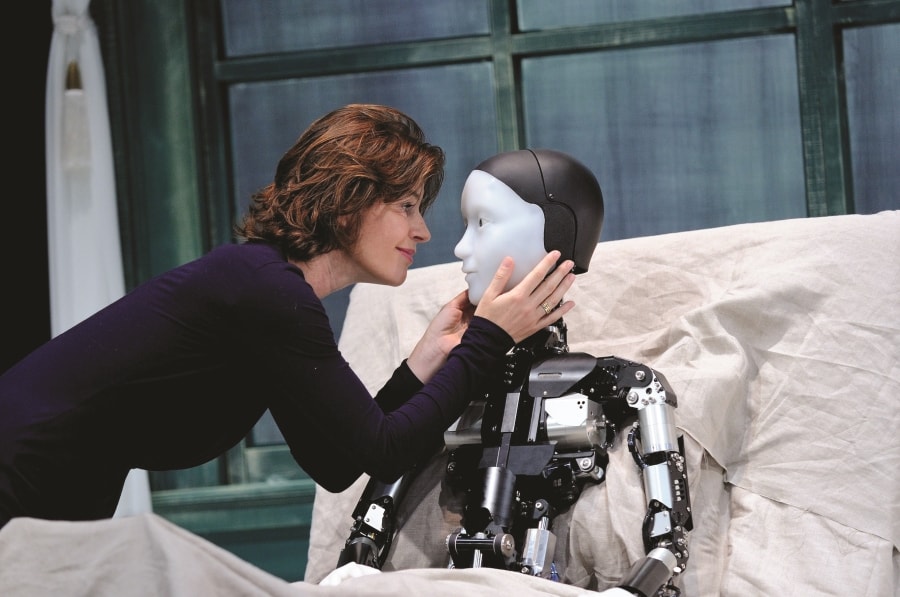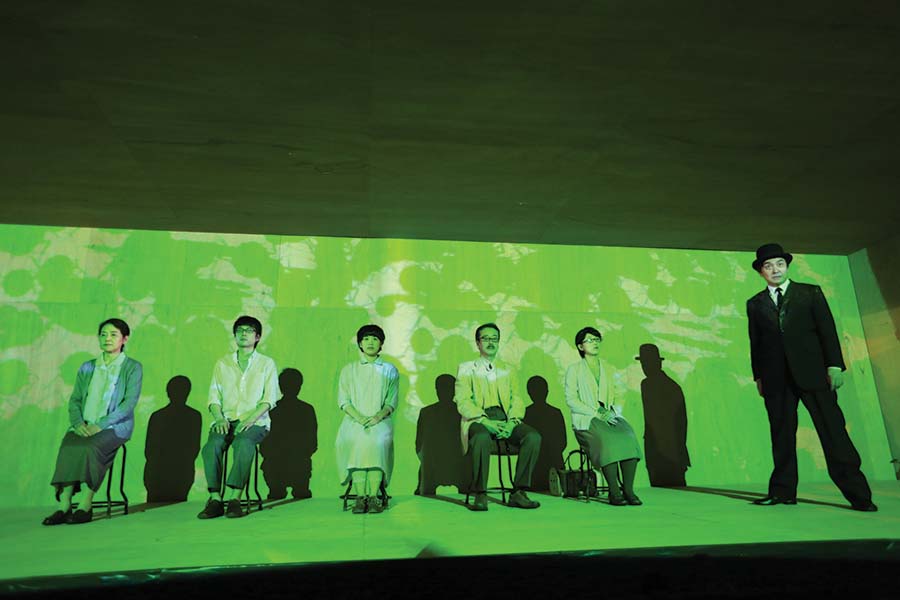Just as, for many Americans, it is difficult to reflect on 9/11 without mass disquietude, for many Japanese 3/11 is not merely another day. At 2:46 p.m. on March 11, 2011, the Tōhoku earthquake and tsunami—better known today as the Fukushima Daiichi Nuclear Power Plant Disaster—rippled along the Northeastern coastline of the island country. This unprecedented triple attack included a magnitude 9.0 earthquake that moved Japan eight feet east, a 9.8-foot tsunami that killed over 15,000 people, and a Level-7 nuclear melt-through of three nuclear vessels.
This multivalent catastrophe, both natural and man-made, might be said to have created an almost complete tabula rasa. In addition to the earthquake and tsunamis, which disrupted tangible space, radiation extinguishes another intangible dimension: time. Considering that Plutonium 239 has a half-life (the period in which 50 percent of nuclides will have undergone nuclear decay) of 24,110 years, nuclear aftermaths indeed seem to defy a human conception of time.
Unfortunately humanity’s sense of emergency does not last for 20,000 years, for good reason: If we were to continue to dwell at length in the same level of hypertension, our nervous systems would soon collapse. That is why, in the current daily life of Japan, the repercussions of Fukushima seem invisible (unless you’re near the epicenter). As early as September 2013, Prime Minister Abe Shinzō unabashedly declared, before the International Olympic Committee, that Fukushima is “under control,” an assurance that was probably crucial to Japan winning the 2020 Olympics. Ostensibly the country has regained its peace, yet one must never forget that this peace is only a palimpsest, resting upon a constant effort to silence anxieties.
If nuclear time defies human time, nuclear fallout deceives human perception. That’s why for some people in Japan (and the rest of the world), the Fukushima nuclear catastrophe was absent to begin with: out of sight, hence out of mind. On the other hand, for others, it is omnipresent. Owing to this simultaneous absence and presence, many Japanese are impelled to broach uncharted domain—that is, they are compelled to seek a new language to aptly express their uncertainties, to rebuild collective values that could mend divided narratives, and to construct a new way of life that is not merely situated prior to but is always aligned with death. When it comes to trying new languages, values, and Lebenschauung (or views of life), theatre—with its physical presence, emotional eloquence, and fictional safeguards—naturally becomes a useful testbed.
Not that theatre has taken what may seem the most obvious reaction and approach: an ecocritical theatre demanding a full cessation of the 54 nuclear power plants in Japan, or a head-on political theatre rigidly questioning the legal liabilities of Tokyo Electric Power Company. Instead a gradual yet sturdy “non-human” turn has been evident. For various reasons, theatremakers have become noticeably more attracted to cyborgs, animals, insects, and ghosts. In its most obvious renditions, human actors perform roles of anthropomorphized non-human beings. One could argue that this is just another form of the techno-animistic imagination prevalent in Japan since long before 3/11. But what must be noted here is that the rationales underpinning this turn toward the non-human have shifted in subtle yet interesting ways after Fukushima.
Japan is considered by many to be a trailblazer of industrial robots and futuristic imagination. From the mangas of Osamu Tezuka’s Astro Boy (1952) and Mitsutru Yokoyama’s Ironman 28 (1956), ideal human-robot kinships have been dreamt of by boys, girls, and many still-adolescent adults. Before 3/11, most of these robots were designed to serve humans as part of a better society, not built to supersede or replace us. In this unthinkingly human-centric register, robots were acknowledged to be essentially inferior to humans; that’s why Atom, the humanoid nine-year-old in Astro Boy, always longed to be treated like a human child.
Since the Fukushima catastrophe, this human-robot hierarchy has been subtly inverted. Forced to realize how easily destructible their social bonds are and how physically vulnerable their bodies could be, many Japanese theatremakers have created androids who “act” onstage as symbols of indestructible immortality—a thing humans have yearned for half-eternally.
Oriza Hirata—playwright, director, leader of Seinendan (Youth group) Theatre Company, and a usual suspect in Francophone theatre festivals—is generally considered the forerunner of Japanese robot theatre. Working with Hiroshi Ishiguro, a roboticist at Osaka University, Hirata has created eight robot theatre productions, including robotic versions of Kenji Miyazawa’s Night on the Galactic Railroad (2013), Franz Kafka’s The Metamorphosis (2014), and the Hamburg State Opera’s Stilles Meer (Silent Sea, 2016) in which a robot (Robovie-R3 by Vstone) appears as a nuclear power plant worker. Hirata even sometimes talks about a near future in which human actors could be completely replaced by androids, reasoning, “They could act in any language; travel cheaply; never get sick; and never complain.”
In his post-3/11 robot theatre productions, Hirata sheds light on the concepts of immortality and integrity. In his android version of Chekhov’s Three Sisters (2012), for instance, the Fukazawa sisters live in a rural town with a formerly thriving robot industry. Their late father, a renowned robot scientist, created an android of his youngest daughter, Ikumi, before he died. (The real Ikumi seems also to have died, though we later learn that she is still alive but has become a hikikomori—a social recluse.) While the older sisters visit their father’s grave to commemorate his death, android Ikumi refrains, because “death does not concern” her; mortality is a purely abstract concept in her mind. Meanwhile other family members seem agonized by the impending death of their community in the face of a declining birthrate, a labor shortage, and fading hope overall—an almost prophetic vision of a near-future Japan. And while they dodge the gloomy topic around the dinner table, the robot Ikumi, programmed to articulate unequivocally, can only reveal the awkward truth. Next to this logically impeccable and immortal robot, humans come to seem increasingly more fragile, flawed, and duplicitous.
This Three Sisters forces the post-Fukushima audience to question whether or not they, like the Fukazawa family, are hiding behind a veil of escapism; indeed they might even envy the fearless “human integrity” so well represented by the android. At the same time, shrewd observers may begin to feel that accepting faults, fragilities, and failures might be the crux of humanity. Either way, Hirata’s Three Sisters demands that we reconsider what is putatively morally “human.”

From the outset of his career, director-playwright Shū Matsui has been questioning the validity of several key concepts of Western humanism, including coherent logic, subjectivity, and individualism, which, in certain cases, seem to run against harmony-oriented Japanese norms. But it wasn’t until the 3/11 catastrophe that Matsui clearly imagined a non-human theatrical universe favoring collectivism over individualism, relativity over subjectivity, and affect over logic.
In Forgetting the Future (Mirai o wasureru, 2013), a character called Shimada Burio (the name is a spoof on the Japanese word for “embryo”) is presented as the world’s first cockroach-human hybrid. In addition to fluently speaking a human language, Burio can also talk through a Deleuzian language of “molecular vibration, chirring, buzzing, clicking, scratching, and scraping,” enabling him to go beyond the formal limits of communication that inevitably draw a boundary between the subject and the object, between me and you.
When facing vulnerable situations like the aftermath of 3/11, Matsui proposes that people must cease prioritizing cognitive functions, at least temporarily, to enjoy a non-linguistic and non-logical form of unity, which he calls “environmental symbiosis.” We must learn to herd with others like critters, in other words, to avoid untoward confrontations in an already calamitous situation. Indexes such as reason, subjectivity, and criticality must be reassessed, as they may be only onerous abstractions that needlessly complicate our already intractable lives.
Toshiki Okada, the writer-director with the theatre company called chelfitsch (a coinage meant to evoke a child attempting to say the English word “selfish”), is among the leading theatre artists in Japan. He initially received acclaim for voicing the uncertainties of the economically vulnerable Lost Generation in productions using “super-real” colloquial Japanese speech matched with ungainly yet eloquent body movements. In 2007 Okada ventured into the international theatre circuit when he was invited to the Kunstenfestivaldesarts in Brussels to present Five Days in March (Sangatsu no itsuka kan).
Since then, though, he has expanded his theatrical vision beyond the solipsistic aesthetics of super-real Japanese. Four months after 3/11, he relocated to Kumamoto, 760 miles south of Tokyo, after living in the suburbs of the metropolis for 38 years. He felt that after the disaster he could no longer “identify” himself with Tokyo, even considering the capital city “something already over, or already lost—at least for me.” His worldview thus changed, Okada could not help but change the “reality” in his stagecraft.
If, in the pre-Fukushima years, Okada was interested in writing about present reality, after the catastrophe he became increasingly interested in fiction—or, in his own words, “alternative realities.” He also looked back to a 600-year-old theatre tradition: In trying to give voice to someone (family, friends, or neighbors) or something (like Tokyo), he adopted the structure of the dream noh (mugen noh), in which the protagonists (shite) are most often resentful or regretful dead spirits. He’s written three plays responding to the Fukushima disaster: Time’s Journey Through a Room (Heya o nagareru jikan no tabi, 2016), Current Location (Genaichi, 2012), and Ground and Floor (Jimen to Yuka, 2013)—a three-hander in which the protagonist is the wife of a 30-something man who now fancies another woman. Until midway through the performance, the audience does not know that the protagonist is actually dead, as she is the one narrating the proceedings, describing the minutest details of everyday life, as if to never forget the life she had led. After providing her tranquil yet unyieldingly articulate monologue, she presses her husband as to whether he remembers the same details she does.
The production seems to find Okada divided between narratives of remembering and forgetting. We humans could not survive a single day if we remembered all the details of the past. But for the dead, the act of forgetting implies their complete disappearance. With the many lives lost in 3/11, theatremakers have begun to feel the obligation to reconsider not only the politics of humans but also those of the dead. Okada has said that “the ghost is a great invention of humans,” a way for us to give body to our imaginations and to our struggles with the past.
Whether looking to the future through androids and hybrid bugs, or veering toward the past through the visions of ghosts, Japanese theatre artists are imagining a time well beyond the lifespan of a single human being. The 3/11 catastrophe may not have changed Japanese society for the better, but it has surely stirred the imaginations of theatre directors and playwrights—and audiences. The non-human turn in post-Fukushima theatre is a clear embodiment of the ways Japanese artists feel responsible for giving voice, not only to those who survived but also to the dead and the unborn.
Kyoko Iwaki, a scholar of Japanese modern and contemporary theatre and performance, is a researcher at Waseda University.
CORRECTION: An earlier version of this story misspelled Tōhoku as Thoku.


